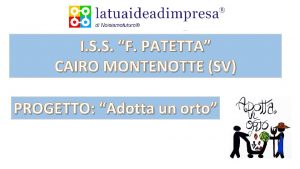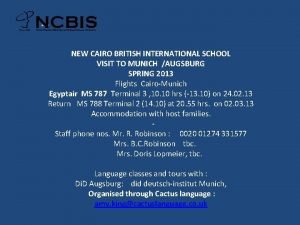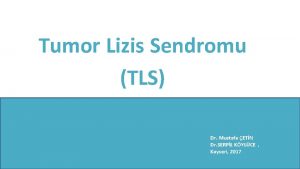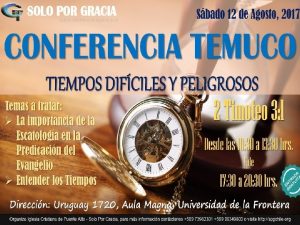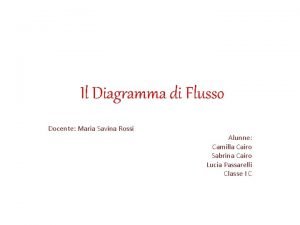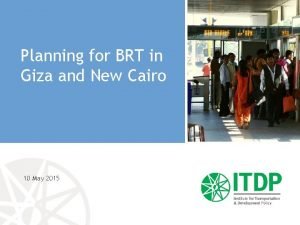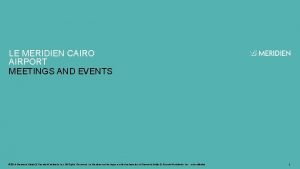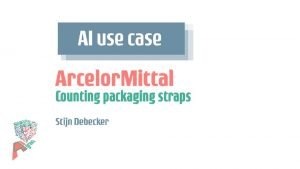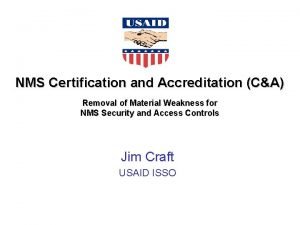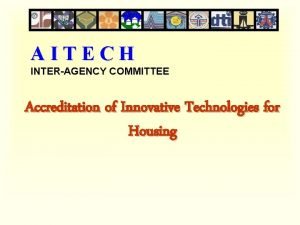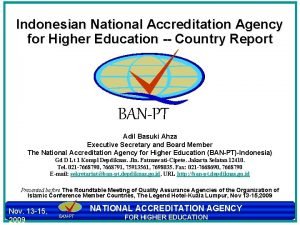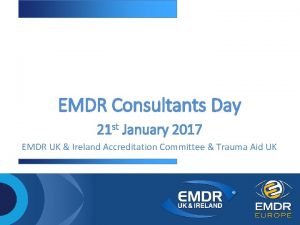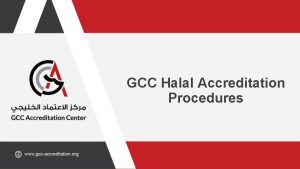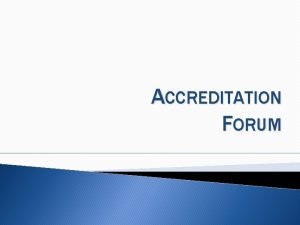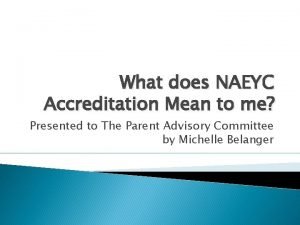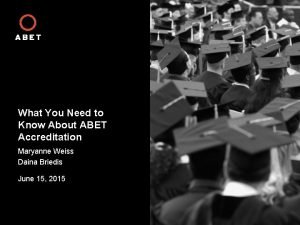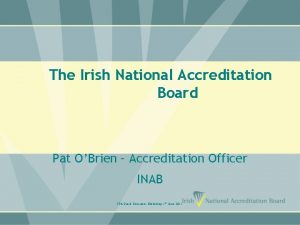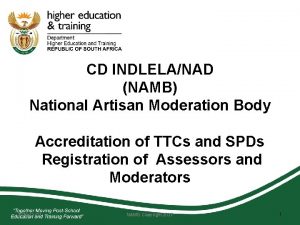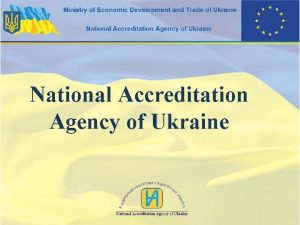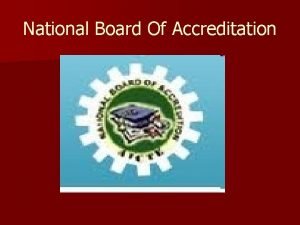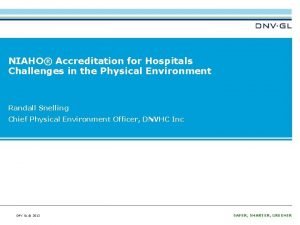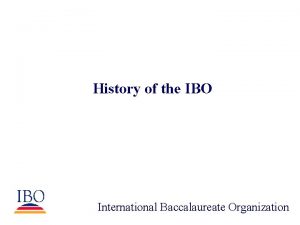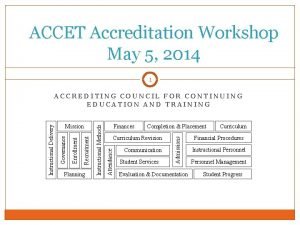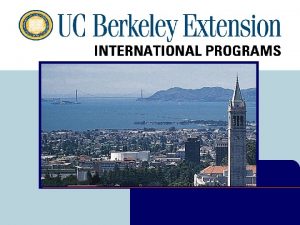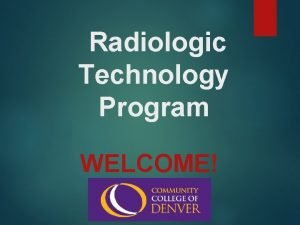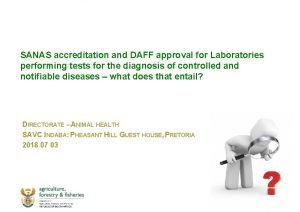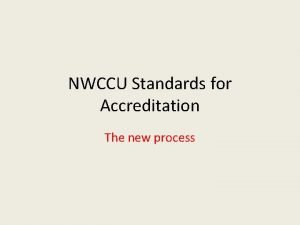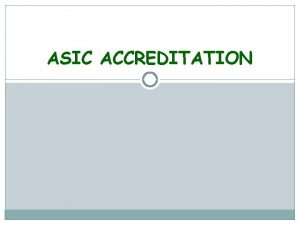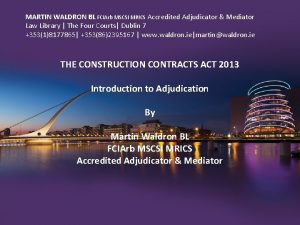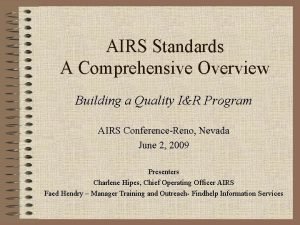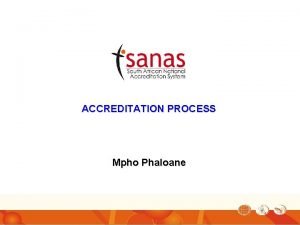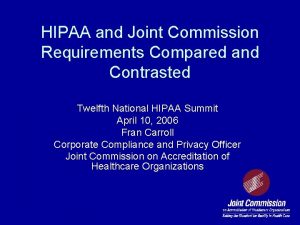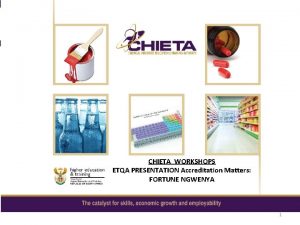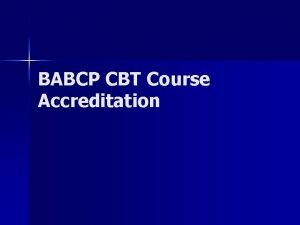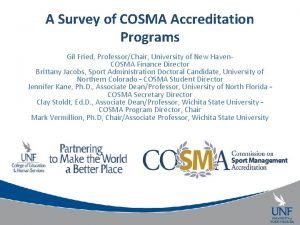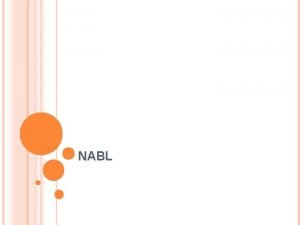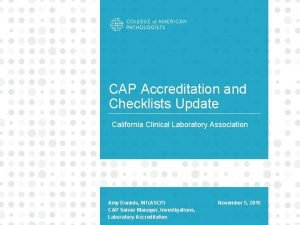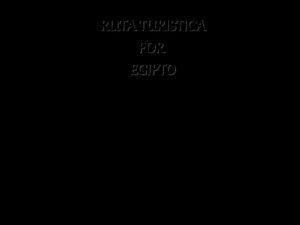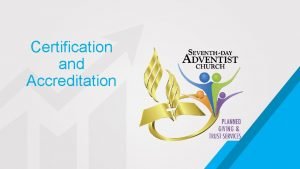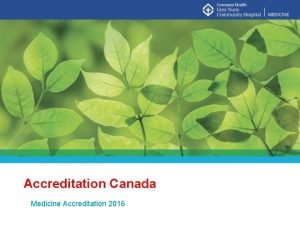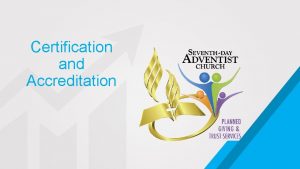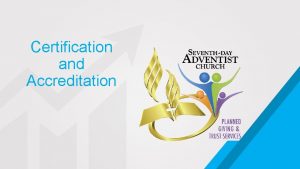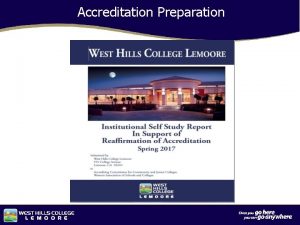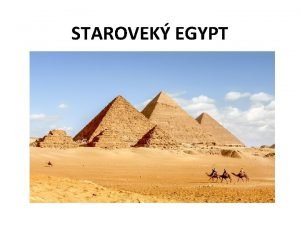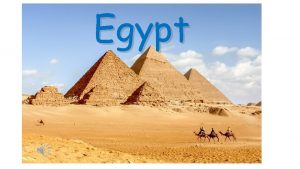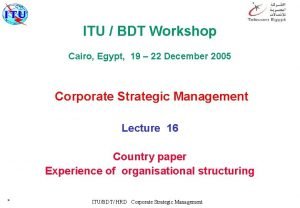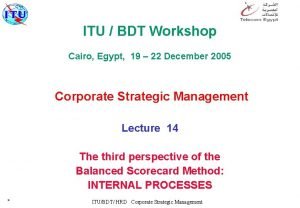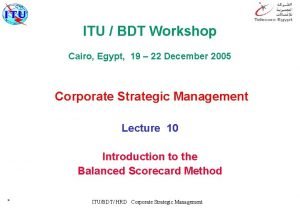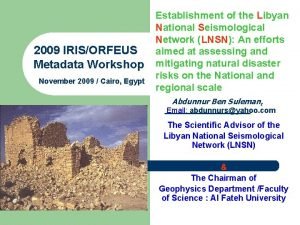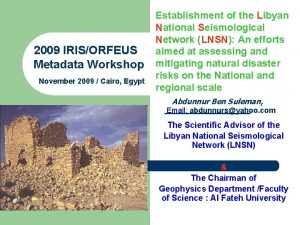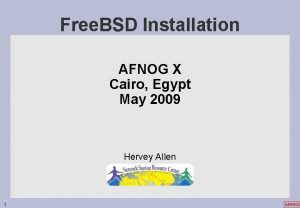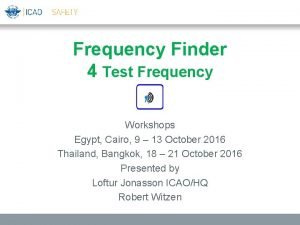Accreditation Workshop Cairo Egypt March 14 16 2010





















































- Slides: 53

Accreditation Workshop Cairo, Egypt March 14 -16, 2010 Tarek M. Sobh, Ph. D. , P. E. , CMfg. E Vice President for Graduate Studies and Research Dean of the School of Engineering Distinguished Professor of Engineering and Computer Science University of Bridgeport 1

Types of Accreditation/Review • Regional • Governmental • Disciplinary • Internal 2

Regional Accreditation 3

Goals for today’s workshop • Increase your understanding of accreditation, the Commission's Standards, including heightened emphases and themes, and the initiative on student success • Discuss how to prepare for the visit and to use your time on campus as productively as possible • Provide practical advice on writing the report, with particular emphasis on how to address institutional effectiveness • Prepare you to win a fabulous prize in the contest at the end of the day! 4

Accreditation A voluntary system of self-regulation carried out by peer review in which an institution or program is found to meet or exceed a set of standards. Accreditation certifies that an institution: • has appropriate purposes • has the resources needed to accomplish its purposes • demonstrates that it is accomplishing its purposes • has the ability continue to accomplish its purposes 5

Dual purposes of accreditation Assure quality Foster improvement The Commission as a “reliable authority” on the quality of education 6

Two-minute history of accreditation 1. Constitution, no national university, Dartmouth College case, private universities first 2. NEASC founded in 1885 3. Standards; Periodic review 5. Link to federal government 6. Like American higher education • • • Decentralized Large – 7000 accredited institutions Diverse Serves a mobile society Porous and forgiving 7

Three-part process • Self-study or report • Site visit by peer evaluators • Commission decision Types of visits: comprehensive, focused, substantive change implementation Accreditation = Standards + Mission 8

What are the Standards? An articulation by the higher education community of what a college or university must do in order to deserve the public trust A framework for institutional development and selfevaluation 9

Standards for Accreditation • Mission and Purposes • • Planning and Evaluation Library and Other Information Resources • • Organization and Governance Physical and Technological Resources • Financial Resources • The Academic Program • Public Disclosure • Faculty • Integrity • Students The revised Standards went into effect in January, 2006 10

Characteristics of the Standards • Mission-centric – institutional autonomy • Aspirational standards to be met at least minimally • Non-prescriptive • Largely qualitative • Evaluation for improvement • Anticipate the future 11

Three-part format for each standard • Statement of the Standard (in bold-face type) • Numbered paragraphs (with subheadings) • Institutional effectiveness 12

Heightened emphases • Institutional capacity • Role of the governing board • Public disclosure • Educational quality and student success • Institutional effectiveness and assessment 13

Institutional capacity 1. 1 The institution’s mission provides the basis upon which the institution identifies its priorities, plans its future and evaluates its endeavors … 2. 3 The institution has a demonstrable record of success in implementing the results of its planning. 4. 10 Institutions undertaking … substantive change demonstrate their capacity to undertake such initiatives and to assure that the new academic programming meets the standards of quality of the institution and the Commission’s Standards and policies. 9. 3 The institution’s multi-year financial planning is realistic and reflects the capacity of the institution to depend on identified sources of revenue and ensure the advancement of educational quality and services for students. 14

Role of the Board The governing board … • Demonstrates sufficient independence to ensure it can act in the institution’s best interest • Includes representation of the public interest and reflects areas of competence needed to fulfill its responsibilities • Has fewer than one-half of its members with any financial interest in the institution • Approves major new initiatives, assuring that they are compatible with institutional mission and capacity • Systematically develops and ensures its own effectiveness • Appoints and periodically reviews the performance of the CEO 15

Public Disclosure The institution’s printed materials and webpages should provide complete, accurate, accessible, and clear information sufficient to allow students and their families, as well as interested others, to make informed decisions about the institution. Especially For. . . Prospective Students Current Students Faculty and Staff Alumni and Donors Parents and Visitors 16

What to disclose? What Aunt Miriam wants to know … • Mission, character, size, location, president, board • Student body: Who goes there? • Programs: What’s on offer for study? • Resources: Faculty, library, labs • Services: What help is available? • Opportunities: What else besides class? • Cost: Tuition and fees, aid, debt • Results: What do graduates do? 17

Public Disclosure data form Paragraph Information Web addresses Print Publications Locations and programs available at branch campuses, other instructional locations, and overseas operations at which students can enroll for a degree, along with a description of programs and services available at each location 10. 8 Programs, courses, services, and personnel not available in any given academic year. 10. 9 Size and characteristics of the student body 10. 9 Description of the campus setting 10. 9 Availability of academic and other support services 10. 9 Range of co-curricular and non-academic opportunities available to students 10. 9 Institutional learning and physical resources from which a student can reasonably be expected to benefit 10. 10 Institutional goals for students' education 10. 11 Success of students in achieving institutional goals including rates of retention and graduation and other measure of student success appropriate to institutional mission. Passage rates for licensure exams, as appropriate 10. 11 Total cost of education, including availability of financial aid and typical length of study 10. 11 Expected amount of student debt upon graduation 10. 13 Statement about accreditation 10. 7 18

Educational Quality In light of the institution’s mission, evaluators assess the quality of • • • Academic programs: curricula, degree objectives (4. 3, 4. 4, 4. 5) Student achievement (4. 46, 4. 50, 6. 6) Faculty (5. 2, 5. 10, 5. 16, 5. 19, 5. 20) Student support services (6. 8, 6. 9, 6. 13, 6. 14) Recruiting and admissions procedures (6. 1, 6. 2, 6. 3) Library and information resources (7. 2, 7. 4, 7. 7, 7. 9) Physical facilities and equipment (8. 1, 8. 2, 8. 3) Fiscal and administrative services (9. 6, 9. 7, 9. 11) Website, catalogs, other institutional “publications” (10. 1, 10. 3) Statement on Credits and Degrees may provide helpful context 19

Balancing Inputs, Processes & Outcomes Inputs There are sufficient, qualified faculty There is appropriate access to adequate library resources Processes Students receive good academic advising Students use library resources Outcomes Faculty are demonstrably effective Students develop skills of information literacy 20

Mission & Standards Institutional Effectiveness Assessment* *What and how students are learning 21

Institutional Effectiveness Defined The Planning and Evaluation standard delineates the processes and outcomes of institutional effectiveness efforts that apply to all areas of the institution. 2. 2: The institution undertakes short- and long-term planning… The institution systematically collects and uses data necessary to support its planning efforts and to enhance institutional effectiveness. 2. 6: The results of evaluation are used systematically for improvement and to inform institutional planning, especially as it relates to student achievement and resource allocation. References to institutional effectiveness appear: • as the last numbered paragraph of each Standard • at many points throughout the Standards 22

Assessment Defined The ‘Assessment of Student Learning’ is defined by a section within the Academic Program standard which contains numbered paragraphs 4. 44 through 4. 50. 4. 44: The institution implements and supports a systematic and broadbased approach to the assessment of student learning focused on educational improvement through understanding what and how students are learning … The assessment of student learning receives specific attention at many other points in the Standards such as: • • • Mission and Purposes (1. 4) Planning and Evaluation (throughout) The Academic Program (throughout) Faculty (5. 3, 5. 10, 5. 13 and 5. 15 -5. 18) Student (6. 7, 6. 17) Library and Other Information Resources (7. 8) 23

A clearer articulation of expectations regarding institutional effectiveness and assessment • Engagement (“It’s always on our agenda”) o campus community o external community • Mission-appropriate approach • Evidence of what students know and can do • Broad support from administration, faculty • Use of assessment results for improvement • Ongoing commitment, integrated into campus culture 24

Institutional self-study • Institutional characteristics • Introduction (describes self-study process) • Overview (sets institutional context) • Narrative • Description: how do we meet the Standards? • Appraisal: how well do we meet the Standards? • Projection: what do we commit to do in the future? • Data Forms (Finance, Enrollment, Student Success) 25

Focused visit report • Introduction • Institutional overview • Areas of focus • Summary appraisal and plans • Finance and Enrollment data forms (if relevant) • Selected appendices 26

Substantive change implementation Examples: higher degree, off-campus location, overseas location, change of ownership Materials provided to evaluators include: • Original proposal submitted to the Commission • Implementation update, including attention to areas of focus identified by the Commission in its review of the proposal 27

The evaluation team Two roles: • Validate the self-study or focused report • Be the “eyes and ears” of the Commission Qualities of an effective evaluator: • Open-minded • Relies on evidence • Works well on a team • Can work quickly and stay on schedule • Understands NEASC standards & can apply them • Can maintain confidentiality 28

Reading the Self-Study/Report • Read the Standards • Read the Commission’s letters and the institution’s history sheet • Take notes • Take advantage of the surrounding material • Form questions, not judgments • Read the Standards again 29

Preparing for the Visit • Review the schedule • Review the list of exhibits/on-line exhibits • Contact your team chair with any requests • Respond promptly to requests from the institution and team chair • Prepare for your interviews • Start thinking about your section of the team report 30

Agenda for the afternoon • Sharing Strategies for Success – lunch discussion • Commission’s initiative on Student Achievement and Success • Writing the team report • Distance education and off-campus programs • Exciting contest with fabulous prizes!! 31

Sharing Strategies for Success As you look at the “Do’s and “Don’ts for NEASC team members” on page 61 • What stands out for you? • What would you add to the list? Each of you will be assigned responsibility for one or more standards … but you can’t do it alone! How will you draw on the expertise of team members who are evaluating other Standards? 32

Commission’s initiative on student success 1992 Policy statement on institutional effectiveness 2006 Revised Standards 2007 Initiative on student achievement and success, with new data forms to enhance reporting and analysis and to put “data first” 33

Why initiatives on student success and data first? • Implementation of the Standards • Better tools available • External reason: Take initiative – or lose initiative • Internal reason: use NSSE” “We do portfolios, ” or “We • Disconnect between data forms and selfstudy narrative 34

What characterizes the initiatives? • Mission-sensitive • Diversity of institutions • Multiple dimensions of success • Trends and promotion of improvement • Promote creativity and sharing 35

Assumptions underlying the initiatives • Greater regularity in reporting will benefit institutions, teams, the Commission, and the general public • Goal is to stimulate greater coherence in institutional approaches and greater sharing among institutions • Not every measure is appropriate for every institution • Some institutions will have multiple instances of a single measure (e. g. , licensure pass rates) • Institutions are encouraged to compare their data with those of peer institutions • Trends in any measure are important 36

Data First Forms New! A series of forms (at least one for each Standard) designed to allow institutions to report key institutional data. Many forms ask for trends over time. A few examples … Std 3: Off-campus locations, distance education Std 4: Enrollment at all levels & locations Std 5: Faculty salaries & assignments Std 6: Admissions, student debt Std 7: Library collections, personnel, instruction, use Std 10: Public disclosure 37

Data First – the name says it all! Institutions are encouraged to: • Complete the forms early in the self-study process • Distributed the forms to writing committees for their use as they work on their chapters. • Analyze the forms by asking: What do we have? What’s missing? “You can see a lot just by looking. ” Yogi Berra 38

New data forms to report on assessment and student success The E-Series: Making Assessment More Explicit Select and declare a basic approach to assessment and summarize the findings The S-Series: Documenting Student Success Report data on retention rates, graduation rates, and other measures of success appropriate to the institution’s mission Included in self-studies beginning in Spring 2009 39

The E-Series: Making Assessment More Explicit Institutions choose one of the following four options: E. 1. Inventory of educational effectiveness indicators and specialized and program accreditation E. 2. Voluntary System of Accountability plus program review E. 3. Institutional claims for student achievement with validating information E. 4. Measures of student success: Comparison with peers or design their own, in consultation with the Commission staff 40

The Questions in Common 1. What is the basic framework or approach? 2. How is the approach formalized or made known? 3. When do the processes occur? 4. What evidence is available? 5. Who uses or interprets the evidence? 6. How has the evidence been used for improvement? 41

The S-Series: Documenting Student Success S. 1. Retention and graduation rates S. 2. Other measures of student achievement and success S. 3. Licensure passage and job placement rates S. 4. Completion and placement rates for shortterm vocational programs Each asks for information about the most recent year, one and two years prior, and goals for the future. 42

Using the data forms in the self-study process • Start early so the data can be collected, analyzed, and used by those engaged in the self-study process. • Appraisal provides an opportunity to reflect on the findings – what and how are students learning? Have we developed the capacity to collect, analyze and use important institutional data, especially data about student achievement and success? • Projection provides an opportunity to state commitments about improvements to institutional efforts to collect, analyze and use data – especially data about student achievement and success – for planning and decision making. 43

The student success forms in the team report • Standard Two: Planning and Evaluation Evidence that the institution evaluates the achievement of its mission and purposes and uses the results for improvement • Standard Four: The Academic Program Evidence that the institution’s approach to assessment focuses on the course, program, and institutional level; uses a variety of quantitative and qualitative methods; uses the results to improve learning opportunities for students • Standard Six: Students Evidence that the institution’s retention and graduation goals reflect institutional purposes; that it has other measures of student success appropriate to its mission; that it uses results for improvement Complete? Reviewed? Discussed? Useful? 44

The Data First forms in the team report • Standard Two: Planning and Evaluation Did the institution find the Data First forms a useful addition to their evaluation processes? • As a “source” for information included in the report E. g. , “As reported in the Data First forms, the percentage of faculty with terminal degrees increased by from 56% to 73% during the last five years. ” • Anywhere the institution did a good job of using the data E. g. , “The information about off-campus locations reported in the Data First forms, and the institution’s appraisal of their oversight of these locations, provided the team with a comprehensive understanding of the complexity of the institution. ” 45

Understanding and using the E&S Data Forms In your small groups Review the excerpts from the E&S Data Forms for Central College and Middle New England University (pp. 109 -117) Questions for your consideration: 1) Overall, how would you characterize each institution’s approach to the assessment of student learning and student success? What progress has been made? What remains to be done? 2) What questions will you want to pursue while you are on campus? With whom will you want to speak? 3) Craft two or three sentences for your team report that summarize the commendations and concerns you have about each institution’s approach to the assessment of student learning and student success. 46

Writing the report • Read the Standards … Write to the Standards • Take notes • Know your preferred working style • Include evidence and analysis as well as description • Balance inputs, processes, and outcomes • Follow the team chair’s lead and meet deadlines • Let’s wipe out those common problems • What else? ? ? Read the Standards 47

Including evidence in the team report • Identify the source • Avoid the passive voice • Be specific • Use numbers • Base judgments on data, not personal experience or opinion 48

Nadir College A strong contender for the award for Worst Team Report Ever Written! For each excerpt from the report: • Identify what’s wrong • Suggest improvements 49

Distance education & off-campus locations • When initially offered, Commission reviews as substantive changes • Per Commission policy, online programs and off-campus locations are reviewed as part of a comprehensive evaluation • All students, all modalities, all locations • Quality, capacity, and oversight 50

Implementation of the HEOA requires … • Verification of distance education students • Verification of transfer policy, including criteria for acceptance of transfer credit (coming soon: a list of institutions with which the college has articulation agreements) • Review of correspondence education (coming soon) 51

t s a l y An , s n o i t ques , s t n e m com s t h g i s in 52

Disciplinary Accreditation Case Example ABET http: //assesseng. bridgeport. edu/ 53
 Relative location of ancient egypt
Relative location of ancient egypt March march dabrowski
March march dabrowski Upper egypt and lower egypt
Upper egypt and lower egypt March 22 2010
March 22 2010 Iss patetta
Iss patetta New cairo british international school
New cairo british international school Devolution ap human geography definition
Devolution ap human geography definition American university in cairo history
American university in cairo history Cairo bishop sınıflaması
Cairo bishop sınıflaması Todos los tiempos el tiempo
Todos los tiempos el tiempo Sabrina cairo
Sabrina cairo Faculty of veterinary medicine cairo university logo
Faculty of veterinary medicine cairo university logo Brt cairo
Brt cairo Dra romilda cairo
Dra romilda cairo Cairo university faculty of veterinary medicine
Cairo university faculty of veterinary medicine Le meridien cairo airport wedding packages
Le meridien cairo airport wedding packages Faculty of veterinary medicine cairo university
Faculty of veterinary medicine cairo university Victor cairo arcelormittal
Victor cairo arcelormittal Mitchell cairo md
Mitchell cairo md Nms accreditation
Nms accreditation Aitech accreditation
Aitech accreditation National accreditation body of indonesia
National accreditation body of indonesia Emdr uk accreditation
Emdr uk accreditation International laboratory accreditation
International laboratory accreditation Aaa accreditation
Aaa accreditation Gcc accreditation center
Gcc accreditation center National board of accreditation questions and answers
National board of accreditation questions and answers Niaho accreditation
Niaho accreditation What does it mean to be naeyc accredited
What does it mean to be naeyc accredited Abet headquarters
Abet headquarters National accreditation board
National accreditation board Indlela trade test centre contact number
Indlela trade test centre contact number Ukraine accreditation body
Ukraine accreditation body National board of accreditation
National board of accreditation Niaho accreditation
Niaho accreditation Is john goormaghtigh alive
Is john goormaghtigh alive Accet accreditation requirements
Accet accreditation requirements Berkeley extension
Berkeley extension Hlc accreditation
Hlc accreditation Sanas accreditation process
Sanas accreditation process Nwccu accreditation standards
Nwccu accreditation standards Asic accreditation
Asic accreditation Martin waldron bl
Martin waldron bl Airs accreditation
Airs accreditation Sanas accreditation process
Sanas accreditation process Joint commission accreditation standards
Joint commission accreditation standards Chieta trade test
Chieta trade test Ea european accreditation
Ea european accreditation Bac british accreditation council
Bac british accreditation council Babcp accreditation
Babcp accreditation Cosma accredited schools
Cosma accredited schools Clinical pathology accreditation
Clinical pathology accreditation International laboratory accreditation cooperation
International laboratory accreditation cooperation Cap laboratory general checklist
Cap laboratory general checklist




